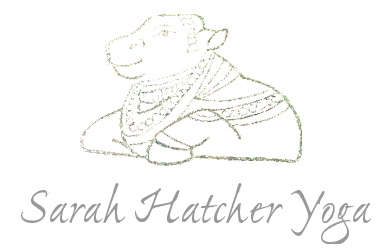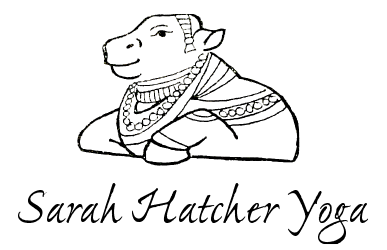Trash talking your Practice
Today I want to share how a few of my friends have just stopped practicing entirely this past year - full stop as they have had enough with the intensity of a regular practice. Without judgement of why someone would stop practicing, why is it?
They have stopped practicing because they have forgotten what brought them to yoga in the first place. I practice daily so that I can align my inner compass and participate with myself and the world around me in a better way. Everyone has their reason for continuing daily practice. Knowing this is an important reminder that gets you on your mat every day. Are you doing it just because? Or are you practicing because you believe there is something in it that guides you to being a better human being? The practice hopefully should invite you to keep returning to practice - in whatever form. One goal of daily practice is to maintain health and wellness - not to lose sight of it.
What happens when we forget this personal coda of why we practice in the first place? We start trash-talking our practices: we begin to over-think our daily practice, we stop listening and start reeling more - we even start to nit-pick the practice and break it apart, seek to make it wrong or right - we actually make up stories in our minds about why we shouldn’t practice. Even looking at photos of other yogis demonstrating great feats of āsana becomes detrimental to our own practices as we begin comparing and losing faith in our own sincere efforts. Another thing some people will do is add another habit in instead of yoga that may even be harmful instead of helpful to achieving yoga.
This is a form of avidyā, where we misunderstand something - get it wrong, or even misinterpret the meaning and then identify with it in the wrong way. We altogether don’t know that it is happening or even know about it at all! Avidyā has the translation as “nescience'“ or “ignorance” (Edwin Bryant). It is the first of the kleśas - the obstacles to yogic practice and they are reduced when we direct our practices (samādhi bhavanaḥ) towards meditation and the three elements of kriyā yogaḥ (Yoga Sūtras 2.1-2.2).
If we go back to the beginning of the Yoga Sūtras, Patañjali invites us to look at our thoughts: since our minds are almost always churning (in the state of ‘vṛttiḥ’) it is going to take some effort to still it (nirodhaḥ). This is yoga! Watching our thought patterns we see that they are either kliṣṭaḥ - not helping us achieve nirodhaḥ (stillness in the mind), or akliṣṭāḥ, helpful. Notice how this word “kliṣṭaḥ” is very similar to the root word of kleśa - obstacles to achieving samādhi (absorption of the self), and both of these words share the same root, “kliś” which means “detrimental” (Edwin Bryant, “The Yoga Sūtras of Patañjali” page 174).
Since our thoughts have the potential to be detrimental to achieving yoga - when we fixate on a memory that is negative or painful (let’s say an injury), then we are going to be adverse to practicing as there is a negative experience. This is one of the kleśas, dveṣa, aversion. It is when we don’t want to do it because there was once pain or suffering (a harmful memory) that we now associate yoga with instead of an akliṣṭāh - a helpful memory - of why we started yoga practice in the first place.
A healthy memory of yoga would be an adjustment one received from a teacher that placed the student in the right alignment; another would be having a relationship with the teacher that is clean and supported; these examples are akliṣtaḥ, helpful. These positive experiences produce memories of success in yoga that builds a healthy foundation to support the habit of regular practice.
Let’s go even closer to how our thoughts turn into habits. If we think something is negative or harmful, of course we aren’t going to do it! And if we have a correct perception about something then we are more likely to practice doing it. We have to be careful with this effort that has brought on joy and stimulus because it could easily lead to attaching it in an unhealthy way: this would be another kleśa - rāga - that could be harmful to maintaining yoga. An example of this is when we over-do the practice. We may not give ourselves 24 hours to recover after a practice and participate in ‘drills’ or extra practices that can be added into the practice instead of doing another practice in the day.
When we specifically look at sūtras 2.4-2.5 of the Yoga Sūtras of Patañjali, we understand why we forget, get it wrong or altogether are ignorant to the deeper meaning of something. Go ahead and have a listen below for the chanting enthusiasts out there of sūtras 2.01-2.05 before we look at it further:
Here is the definition of avidyā: 2.04-2.05:
“avidyā kṣetramuttareṣāṁ prasupta-tanu-viccinnodārāṇām” (Yoga Sūtra 2.04).
Ignorance (avidyā) is the breeding ground (‘field’ kṣetram) for all the other kleśas (uttareṣām). They are present in four types of forms - either
dormant (prasupta),
weak (tanu), or
interrupted or intermittent (vicchinna) or
in full form or fruition (manifest or udārāṇām).
Further, ignorance is the notion (khyātiḥ) that misidentifies the self (ātma) for the nonself (anātmasu), Notice the lists of opposites:
anityāśuci-duḥkhānātmasu nitya-śuci-sukhātma-khyātiravidyā (Yoga Sūtra 2.05).
Ānatmasu - non self vs ātma true self
anitya temporary vs nitya eternal
aśuci unclean vs śuci pure
duḥkha painful vs sukha joyful
Now that my 6 1/2 year old son Dash is back at school, the habit he had before lockdown was to lay his clothes out the night before. This simple habit saves time, gets him out the door on his bike faster, and is a sure-way to get him ready for the day. One early morning routine you can do to support getting on your mat every day so you can be successful in your practice - is set a practical time for practicing every day; do it preferably at the same time everyday; in the same spot in your home, and with the same preparedness that Dash does: lay your clothes out the night before yogi! And if you don’t, you may be so tired searching for your socks in the morning that you fall asleep on a bench…with your helmet on!
Notice how it would be so easy to think that through diet or taking in something not healthy for us may bring a quick reward of joy or even ease, but later may actually bring us into a state of fogginess or dispair? Also notice how if we think money will bring us a better life, “If only I had that job I would be so much happier”, but really it isn’t that at all - it is through our austerities which have brought us clarity that we learn how to be independent with ourselves and then through this realisation, happiness comes. Healthy thoughts create healthy actions; healthy actions lead to healthy habits.
Now that we are established in a practice there becomes a time when it is clear that something is not right. Often there is pain in the body that comes up out of nowhere. An example of this would be a pain in the shoulder for example when doing downward dog. The pain isn’t from the downward dog, it is a result of our day-job or an other activity we have done for a long time that has caused an accumulated problem in our shoulder and it comes out in the practice: there was something dormant (prasupta) and when we started peeling away layers of the physical and penetrating the internal, it was revealed.
In the beginning we are first caught up in learning how to do yoga correctly and tending to our temples and finding some ease in the physical. We accumulate some poses, start practicing more and more and then what happens - we learn less postures and learn more about our thoughts and patterns, our habits and learn how to be still. We can do this because we have mended the body (that niggly shoulder that mended itself out with a little time, rest and reflection), and now we are working inside on our thoughts.
Because the asanas aren’t coming anymore, we investigate the single position of stillness in our yoga practices more often. This is quite important for the longevity of your daily practice - to find the single position of stillness more often and finding it easier. It doesn’t at all have to be done in a full practice to find this - could be just a few standing postures that bring us to this awareness.
For the yogis out there who are thinking:
“Well, I don’t have a shala anymore…”
“I don’t have the teacher I want…”
”And my house isn't warm…”
”I have gained too much weight during the pandemic to do yoga.”
or even “I don’t like that method anymore and yoga isn’t that great”
Have a little journal time today or tomorrow and give yourself a think - was there something that came up in your life that dissuaded you to stop practicing? And what is it that brought you to yoga in the first place? Remember that time and place - it will inspire you to get back on your mat - start with doing a little bit of breathing and moving - breathing with sound and moving in the asanas that you know best and you know will bring stability and clarity. Don’t go jumping into Kurmasana or put the pressure on yourself to do the practice like you did once before - go back to the simple postures that brought stability in your body and in your mind. (Downward dog, Triangle Posture or even just a simple Padmasana or Sukhasana would be a few to name).
Below is most recent Ashtanga Yoga Conference where I talk just about this avidyā - if you are curious more about patterns or obstacles that are preventing you from practicing, have a listen and perhaps someone in the online community or myself may inspire you to get you back on your mat breathing with sound.
Happy practice to you dear yogi, and may the Yoga Sūtras of Patañjali bring you insight into what may be hidden.
ॐ
The classic Downward-facing Dog - Adho Mukha Svanāsana. Find clarity in this single position without judgment; breathing with sound and ease, make this posture your first posture of the day. Do it without strain. Lift the arches of the feet, anchor the feels down, lengthen your spine and straighten your arms and legs (later they will straighten, beginners they may be bent for a while - then you focus on your back being long and free). Breathe easily through both nostrils with the sound of the ujjayi breath - and gaze at your navel or your thighs bones. Reach your arms into the earth and stamp your limbs into the floor. Let your spine suspend and hang like a great bridge supported by the breath and the upward moving diaphragmatic lift. Draw the navel in and rejoice.



